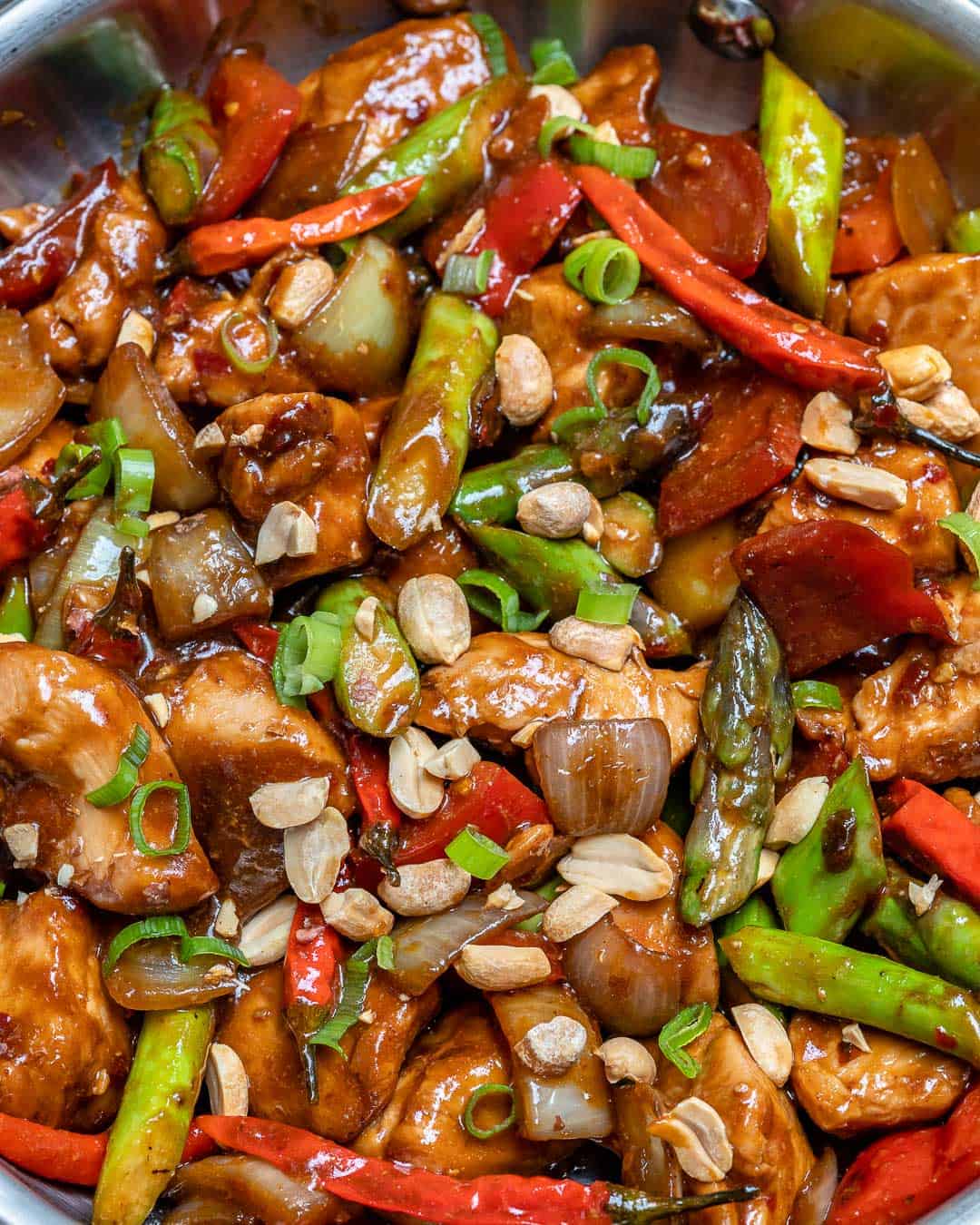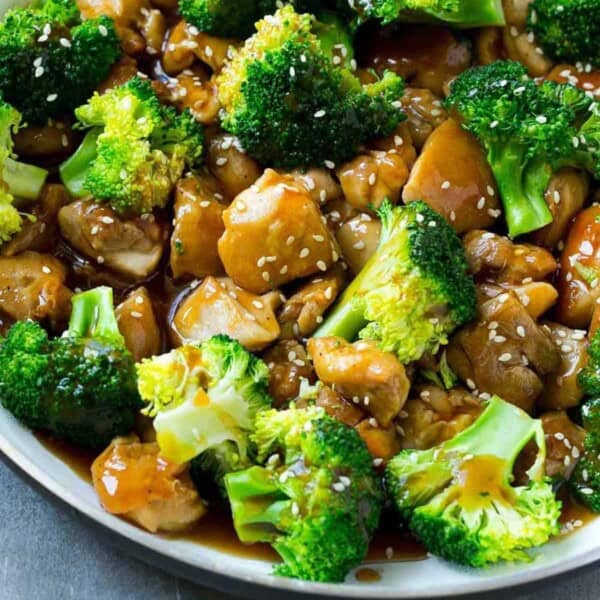This post may contain affiliate links. Please read our disclosure policy.
This authentic Kung Pao Chicken recipe is made healthier so you can now enjoy your favorite Chinese takeout right at home. Stir-fried chicken breast with the perfect combination of salty, spicy, and sweet Kung Pao Sauce recipe.

This easy Kung Pao Chicken recipe rivals the classic takeout recipe you love so dearly at your favorite Chinese restaurant. Yes, the take-out Kung pao chicken is amazing. But how about making the healthier takeout version while you get the same great taste and fewer calories? Made with lean chicken breasts that are cut into small chunk sizes, sauteed with bell peppers and added veggies and tossed in with a sweet, tangy and spicy sauce. Top with some crunchy roasted peanuts and then add over some brown rice, cauliflower rice or some quinoa.
For more at-home versions of takeout favorites, check out Easy Shrimp Fried Rice, Kung Pao Shrimp, Chicken Lo Mein, Mongolian Chicken, and Easy Sweet and Sour Chicken.
Why You Will Love This Recipe
- Healthier Alternative: This recipe is a healthier take on the classic Kung Pao Chicken, allowing you to enjoy the delicious flavors of Chinese takeout with fewer calories.
- Abundance of Veggies: The bell peppers, asparagus, and other veggies adds a variety of nutrients, colors, and textures to the dish, making it a well-rounded and wholesome meal.
- Delicious Sauce: The Kung Pao Sauce combines the perfect blend of salty, spicy, sweet, and tangy flavors, creating a unique and satisfying taste experience.

Kung Pao Chicken Ingredients
This Great recipe for Kung Pao Chicken comes together in a flash! Here’s what you’ll need:
- Boneless Skinless Chicken Breasts: You can also use chicken thighs if you prefer.
- Vegetable Oil: For sauteing the chicken and vegetables. Sesame or nut oil will work too
- Vegetables including white onion, asparagus, green onions, and red bell peppers pack this dish with flavor.
- Chopped Roasted Peanuts: Provides a crunchy texture to the authentic Kung Pao Chicken recipe.
- The Kung Pao sauce is made with cornstarch, low-sodium soy sauce, sesame oil, rice whine or rice vinegar, honey, garlic, ginger, and chili flakes.
- Optional: Serve this Kung Pao Chicken recipe over white rice, brown rice, or a low-carb alternative like cauliflower rice.

How to Make This Recipe
- Prepare the Sauce: Whisk together cornstarch, low-sodium soy sauce, sesame oil, water, rice vinegar, honey, minced garlic, minced ginger, and chili flakes.
- Marinate the Chicken: Place diced chicken in a shallow dish, pour half of the sauce over it, and marinate for at least 15 minutes.
- Sauté the Chicken: Heat vegetable oil in a wok or large skillet over medium-high heat. Add marinated chicken in a single layer. Cook for 2-3 minutes until it starts to brown, then stir and cook for an additional 1-2 minutes, or until almost cooked through.
- Add Vegetables: Stir in diced white onion, asparagus pieces, and diced red bell peppers. Stir-fry for an additional 2-3 minutes.
- Simmer with Remaining Sauce: Pour over the remaining sauce, simmer, stirring frequently for a couple of minutes more.
- Finish and Serve: Take the wok off the heat. Sprinkle with chopped roasted peanuts and thinly sliced green onions. Serve over cooked brown rice or cauliflower rice. Enjoy!

Expert Tips
- Cut the chicken into uniform 1-inch cubes to ensure even cooking. Don’t forget, you may use chicken thighs if you prefer, but we recommend you trim out most of the fat if possible to cut down on the calories.
- Allow the chicken to marinate for at least 15 minutes. This step enhances the flavor and tenderness of the chicken.
- Be sure to trim the tough ends of the asparagus.
- Adjust the honey and chili flakes to your taste preference to make the sauces sweeter or spicier.
- Add as much or less of the dried chili peppers. Whatever you can handle.
- If you do not have rice wine or rice vinegar, you may use dry sherry or even balsamic vinegar.
- Dark soy sauce or low-sodium soy sauce will work. If you prefer using coconut aminos that’s fine as well.
- If you have gluten allergies, use gluten-free ingredients, there are many options out there now.
Frequently Asked Questions
Kung Pao sauce has a unique sweet, spicy, and tangy taste to it. The combination of these unique flavors makes it a winner among many Chinese dishes. Furthermore, Kung Pao sauce tastes great with chicken or shrimp, topped usually with crunchy salted peanuts.
The spice level can be tailored to your preference by adjusting the amount of chili flakes. Start with a smaller quantity and add more if desired.
Avoid overcooking the chicken. Stir frequently during the sautéing process, and remove it from the heat as soon as it’s almost cooked through.
Kung Pao Chicken is a popular Chinese dish that is said to have originated in the Sichuan province. It is a stir-fry dish that is made with diced chicken, peanuts, vegetables, some bell peppers, and other veggies like zucchini, and then tossed in a savory and slightly spicy sauce. The taste of Kung Pao Chicken often has a balance of sweet, salty, and tangy flavors.

Serving suggestions
I love to serve this easy Kung Pao Chicken recipe over brown rice, jasmine rice, or quinoa. For a low-carb option, you could also serve it over cauliflower rice.
Kung Pao Chicken Calories
Compared to the kung pao chicken served at fast food places and restaurants like Panda Express or PF Changs, our recipe has 492 calories per serving with 42g of protein, and 28g of carbs. A single serving of kung pao chicken at a restaurant is close to 800 calories.
Storage Recommendations
This authentic Kung Pao Chicken recipe is even better the next day! Here’s how to store it:
- Make Ahead: You can prepare the Kung Pao sauce in advance by combining all the ingredients, whisking them thoroughly, and storing the sauce in an airtight container. Refrigerate for up to 2-3 days, giving it a good stir before use.
- Storing: Leftover Kung Pao Chicken can be stored in an airtight container in the refrigerator for 3-4 days. For extended storage, freeze in a labeled, freezer-safe container. For a better texture upon reheating, consider separating the rice from the stir-fry.
- Reheating: When reheating on the stovetop, use a non-stick pan over medium heat with a splash of water or broth to prevent sticking. Stir occasionally until thoroughly warmed. Alternatively, microwave leftovers in a covered, microwave-safe dish in 30-second intervals, stirring between each interval.

More Chicken Recipes
- Grilled Chicken Kafta
- Chicken Cauliflower Rice Casserole
- Baked Balsamic Cranberry Chicken
- Creamy Chicken Enchilada Soup
- Rosemary Maple Glazed Chicken Breast
- Chicken Meatballs In Cranberry Sauce

If you try a recipe and you like it, leave us some feedback in the comment section below, and don’t forget to rate it! We would love it if you shared it with friends and family.
Finally, please use our hashtag #healthyfitnessmeals on INSTAGRAM for a chance to be featured! FOLLOW Healthy Fitness Meals on FACEBOOK | INSTAGRAM | PINTEREST | TWITTER for all of our latest blog posts and recipes.





1/4 cup of sesame oil? Sounds like alot
It’s only 4 tablespoons. You can definitely only use 2 tablespoons or less
I was wondering at what point do uou add the dried chili peppers?
Add it in with the veggies in step 5.
Thank you,
This was very helpful
we are on WW
Thank you. Glad you liked it